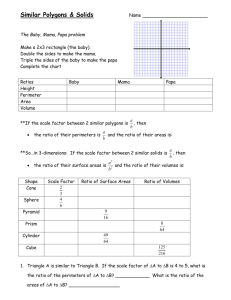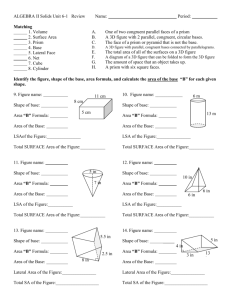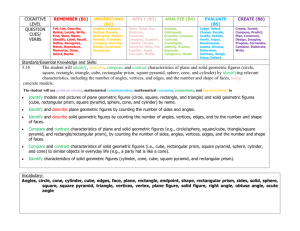Lesson 9: Three-Dimensional Geometry
advertisement
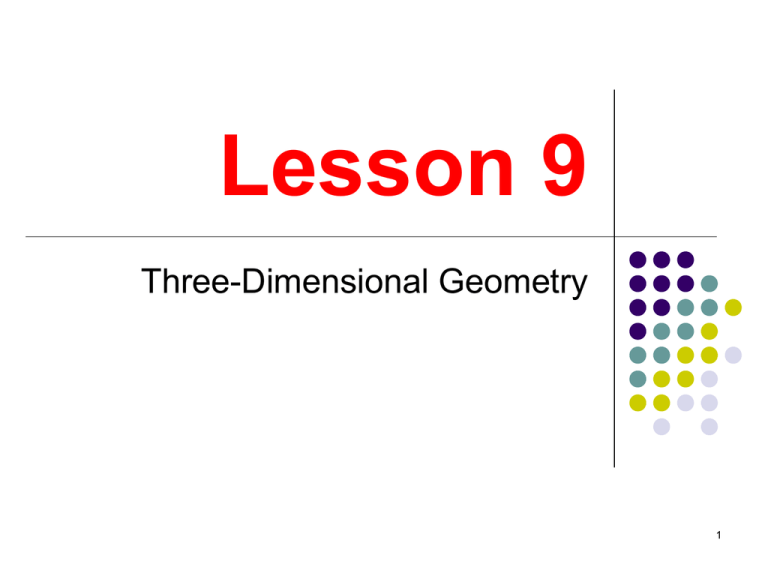
Lesson 9 Three-Dimensional Geometry 1 Planes • A plane is a flat surface (think tabletop) that extends forever in all directions. • It is a two-dimensional figure. • Three non-collinear points determine a plane. • So far, all of the geometry we’ve done in these lessons took place in a plane. • But objects in the real world are threedimensional, so we will have to leave the plane and talk about objects like spheres, boxes, cones, and cylinders. 2 Boxes • A box (also called a right parallelepiped) is just what the name box suggests. One is shown to the right. • A box has six rectangular faces, twelve edges, and eight vertices. • A box has a length, width, and height (or base, height, and depth). • These three dimensions are marked in the figure. H L W 3 Volume and Surface Area • The volume of a three-dimensional object measures the amount of “space” the object takes up. • Volume can be thought of as a capacity and units for volume include cubic centimeters (cm3 ), cubic yards, and gallons. • The surface area of a three-dimensional object is, as the name suggests, the area of its surface. 4 Volume and Surface Area of a Box • The volume of a box is found by multiplying its three dimensions together: V L W H • The surface area of a box is found by adding the areas of its six rectangular faces. Since we already know how to find the area of a rectangle, no formula is necessary. H L W 5 Example • Find the volume and surface area of the box shown. • The volume is 8 5 4 40 4 160 • The surface area is 85 85 5 4 5 4 8 4 8 4 40 40 20 20 32 32 184 4 8 5 6 Cubes • A cube is a box with three equal dimensions (length = width = height). • Since a cube is a box, the same formulas for volume and surface area hold. • If s denotes the length of an edge of a 3 cube, then its volume is s and its surface area is 6s 2 . 7 Prisms • A prism is a three-dimensional solid with two congruent bases that lie in parallel planes, one directly above the other, and with edges connecting the corresponding vertices of the bases. • The bases can be any shape and the name of the prism is based on the name of the bases. • For example, the prism shown at right is a triangular prism. • The volume of a prism is found by multiplying the area of its base by its height. • The surface area of a prism is found by adding the areas of all of its polygonal faces including its bases. 8 Cylinders • A cylinder is a prism in which the bases are circles. • The volume of a cylinder is the area of its base times its height: V r 2h h • The surface area of a cylinder is: A 2 r 2 2 rh r 9 Pyramids • A pyramid is a three-dimensional solid with one polygonal base and with line segments connecting the vertices of the base to a single point somewhere above the base. • There are different kinds of pyramids depending on what shape the base is. To the right is a rectangular pyramid. • To find the volume of a pyramid, multiply one-third the area of its base by its height. • To find the surface area of a pyramid, add the areas of all of its faces. 10 Cones • A cone is like a pyramid but with a circular base instead of a polygonal base. • The volume of a cone is one-third the area of its base times its height: 1 2 V r h 3 • The surface area of a cone is: A r 2 r r 2 h2 h r 11 Spheres • Sphere is the mathematical word for “ball.” It is the set of all points in space a fixed distance from a given point called the center of the sphere. • A sphere has a radius and diameter, just like a circle does. • The volume of a sphere is: r 4 3 V r 3 • The surface area of a sphere is: A 4 r 2 12


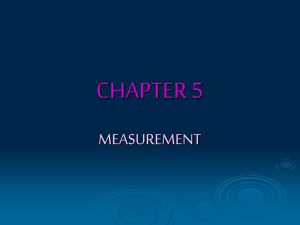
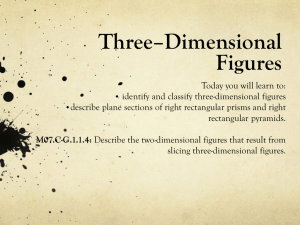


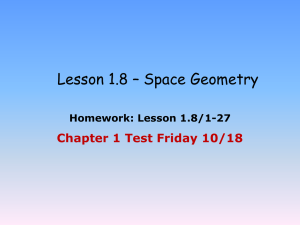
![Volume of Pyramids, Cones, and Spheres [12/4/2013]](http://s2.studylib.net/store/data/005724855_1-4c0eaf218975fc4d9fe792c18193e4dc-300x300.png)
